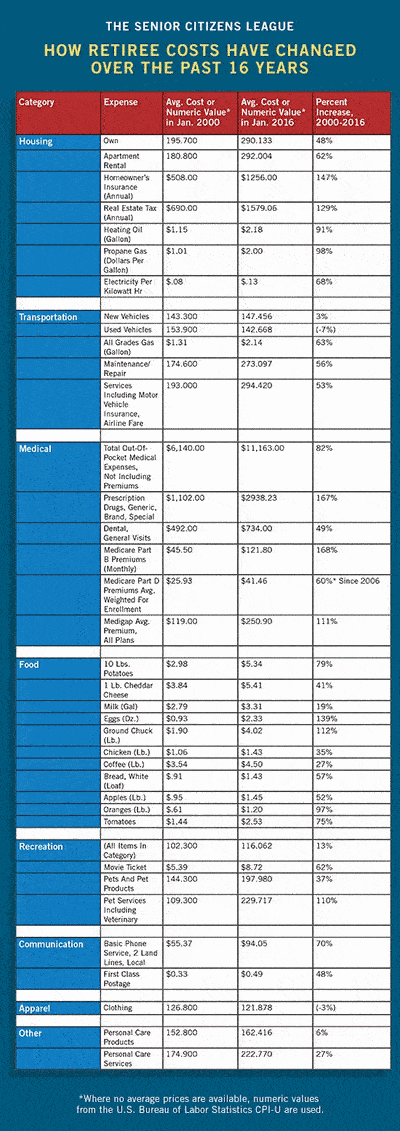U.S. Social Security Benefits Lose 23% of Buying Power Since 2000
Author: The Senior Citizens League
Published: 2016/06/02
Category Topic: U.S. Social Security - Academic Publications
Page Content: Synopsis - Introduction - Main
Synopsis: According to 2016 Survey of Senior Costs released by The Senior Citizens League Social Security beneficiaries have lost 23% of their buying power since 2000.
Introduction
Social Security beneficiaries have lost 23 percent of their buying power since 2000, according to the 2016 Survey of Senior Costs released by The Senior Citizens League (TSCL). The findings indicate that except for higher medical and prescription drug costs, overall prices have changed relatively little over the past year. Inflation remains very low, almost nil, mainly due to the dramatic drop in oil prices. "TSCL is concerned, " says TSCL Chairman Ed Cates. There appears to be a high risk of either an extremely low annual cost-of-living adjustment (COLA) next year, or worse - none at all," he says.
Main Content
Older Americans and disabled Social Security beneficiaries received no cost-of-living adjustment (COLA) in 2016 due to low inflation last year, but TSCL's new survey found that lower inflation didn't translate into lower household expenses in 2015. In fact, nearly 1,200 survey respondents recently said that monthly household expenses made steep increases in 2015. The majority, 72%, indicated their monthly expenses went up by more than $79. "With today's Social Security benefit averaging $1,230 per month, that's an unsustainable level when there's no benefit increase to match," Cates says.
In most years, Social Security beneficiaries receive a small increase in their Social Security checks, intended to help them keep up with rising costs. But since 2000, the COLAs rose a total of just 36.3 percentage points while typical senior expenses have jumped 75.3 percent. "Going without any COLA in 2016 has long-term consequences for retirees when real costs continue to climb," Cates says. "People must spend down retirement savings more quickly than expected, and those without savings are either going into debt, or going without," he says.
A person with average Social Security benefits in 2000 received $816 per month, a figure that rose to $1,166.30 by 2016. However, according to the survey, that individual would require a Social Security benefit of $1,430.50 per month in 2016 just to maintain his or her 2000 buying power, the study found.
The study examined the increase in costs of 38 key items between 2000 and January 2016. The items were chosen because they are typical of the costs that most Social Security recipients must bear. Of the 38 costs analyzed, 29 exceeded the amount of increase in the COLA over the same period. The selected items represent eight categories, weighted by approximate expenditure.
"This study illustrates why Congress should enact legislation to provide an emergency COLA this year," says Cates. "To put it in perspective, for every $100 worth of expenses seniors could afford in 2000, they can afford just $77.00 today," Cates adds.
A majority of the 57 million senior and disabled Americans who receive Social Security depend on it for at least 50 percent of their total income, and one in four beneficiaries relies on it for 90 percent or more of his or her total income. To help protect buying power of benefits, TSCL supports legislation that would base COLAs on the Consumer Price Index for the Elderly. TSCL and its members are lobbying Congress for an emergency COLA for 2016.

With 1.2 million supporters, The Senior Citizens League is one of the nation's largest nonpartisan seniors groups. Its mission is to promote and assist members and supporters, to educate and alert senior citizens about their rights and freedoms as U.S. Citizens, and to protect and defend the benefits senior citizens have earned and paid for. The Senior Citizens League is a proud affiliate of The Retired Enlisted Association. Visit www.SeniorsLeague.org for more information.
STUDY METHODOLOGY
seniorsleague.org/2016/2016-buying-power-study-methodology/